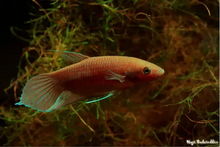Betta akarensis
| Akar betta | |
|---|---|

| |
| Scientific classification | |
| Domain: | Eukaryota |
| Kingdom: | Animalia |
| Phylum: | Chordata |
| Class: | Actinopterygii |
| Order: | Anabantiformes |
| Family: | Osphronemidae |
| Genus: | Betta |
| Species: | B. akarensis |
| Binomial name | |
| Betta akarensis | |
| Synonyms | |
| |
Betta akarensis, the Akar betta, is a species of gourami endemic to south-east Sarawak, and whose species name akar was so named after where it was originally found in the river Sungai Akar. This species is a mouthbrooder,[4] and grows to a length of 10 centimetres (3.9 in) SL. According to Linke, they "live predominantly in mineral-poor, slightly acid water enriched with humic substances".[5]
Morphology and description
Betta akarensis is a fish that measures 14 cm (5.5 in). Dorsal spines (total): 1; Dorsal soft rays (total): 7–8; Anal spines: 1–2; Anal soft rays: 26–28; Vertebrae: 31–32.[6]
Habitat and distribution
Betta akarensis lives in swampy forests, peat bogs, and acidic water. They are usually found in a more stagnant section of the streams among the leaf litter and submerged vegetation that dominates the bank. They are mouthbrooders. It is an adaptable fish and has even been seen in roadside ditches and larger ponds. They are native to Borneo where it has been found in Brunei (Darussalam), and Malaysian Borneo (Sarawak).[7]
Diet
Betta akarensis preys on insects such as Drosophila spp. (fruit flies) that lie on the surface and has been seen taking very small fish as well.[7]
Reproduction and development
Betta akarensis is a paternal mouthbrooder. The female plays the more active role in initiating courtship and defending the area against intruders. After courting, eggs and milt are released during an ’embrace’ typical of anabantoids in which the male wraps his body around the female. Several ‘practice’ embraces may be required before any eggs are released.[7]Once spawning commences, eggs are laid in small batches and picked up in the mouth of the female before being spat out into the water for the male to catch. Once the male has all the eggs in his mouth the cycle is repeated until the female is spent of eggs, a process which can take some time. The incubation period is 10 – 21 days at which point the male will begin to release fully-formed, free-swimming fry. It has been seen that the male accidentally swallows or releases the fry prematurely when stressed. The fry are large enough to consume motile foods such as microworm and Artemia nauplii immediately.[7]
References
- ^ Low, B.W. (2019). "Betta akarensis". IUCN Red List of Threatened Species. 2019: e.T91307091A91307101. doi:10.2305/IUCN.UK.2019-2.RLTS.T91307091A91307101.en. Retrieved 20 November 2021.
- ^ Vierke, Jörg (1988), "Bettas, Goramis and other Anabantoids", Labyrinth Fishes of the World, Nepture, New Jersey: T. F. H. Publications Inc., pp. 118–119,
The date of first description is again erroneously reported as 1909, as are also B. fusca, B. taeniata and other species published in this work. In fact, Regan's work was first published in April 1910.
- ^ Regan, Charles Tate (1910). "The Asiatic Fishes of the Family Anabantidae". Proc. Zool. Soc. Lond. 4: 779.
- ^ Vierke, Jörg (1988), "Bettas, Goramis and other Anabantoids", Labyrinth Fishes of the World, Nepture, New Jersey: T. F. H. Publications Inc., p. 119
- ^ Linke, Horste (2012), "Betta akarensis REGAN, 1910", Labyrinth Fish World, Taiwan: Fish Magazine Taiwan, p. 35, ISBN 978-986-84527-7-0
- ^ "Akar Betta".
- ^ a b c d "Betta akarensis - Seriously Fish". Seriously Fish.

